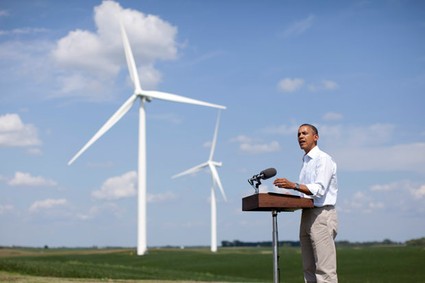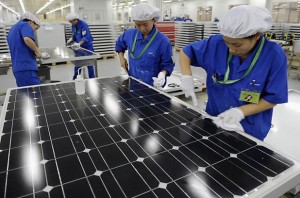Vacationing at the beach always provokes amazing sensory experiences. Everything about lounging in the sand soaking up sunshine, hearing waves crash along the shore, feeling a gentle breeze, and watching a sunset infused with citrus colors relaxes the mind, body, and soul. Now picture an arc of sparkling white turbines dotting the horizon and reflecting the setting sun, their blades twirling as waves tumble below. The image in itself is striking, made only more majestic by the prospect of a clean energy future. The ability to build turbines that each produce 6 megawatts of clean energy in offshore locations seems unreal. Wind capturing technology has made incredible strides since grain-grinding mills first became widespread, but something is holding it back from reaching its potential.
Tag Archives: renewable
Machinations on Machines: Turbines Take the Stand in Politics
The energy market has always been at the forefront of politics, though recent arguments seem like no more than a pissing match between the fossil fuel industry and everyone else. Many decisions have been made not for the overall pros or cons of a particular sector, but based on who can raise more funding—and more hell—in Washington.
Subsidies, Tax-breaks, and the Obama Administration
 The Obama administration has made it a point to support and promote renewable energy resources. In 2012, President Obama’s campaign focused on wind energy as a realistic and effective supplier of power for states like Iowa and Colorado, promising to extend a renewable energy production tax credit while he was in office. Now, in 2014, over $14 billion has been granted to wind energy contractors since 2009, either in the form of this production tax credit, or as part of a renewable energy subsidy afforded by Obama’s stimulus package.
The Obama administration has made it a point to support and promote renewable energy resources. In 2012, President Obama’s campaign focused on wind energy as a realistic and effective supplier of power for states like Iowa and Colorado, promising to extend a renewable energy production tax credit while he was in office. Now, in 2014, over $14 billion has been granted to wind energy contractors since 2009, either in the form of this production tax credit, or as part of a renewable energy subsidy afforded by Obama’s stimulus package.
Against the Wind-or With it?
 Wind is a natural phenomenon that occurs when molecules move freely in response to differences in air pressure. Likewise, energy can be harnessed for human consumption when blades of a turbine move in response to these innate fluctuations. Wind farming allows for the production of relatively clean energy. The price of this energy, however, is far from free.
Wind is a natural phenomenon that occurs when molecules move freely in response to differences in air pressure. Likewise, energy can be harnessed for human consumption when blades of a turbine move in response to these innate fluctuations. Wind farming allows for the production of relatively clean energy. The price of this energy, however, is far from free.
China’s Economic Miracle and Environmental Hope
In terms of scale and speed, China’s economic transformation has no historical precedent: since initiating market reforms in 1978 China has shifted from a centrally planned economy to a market based one. In 1978 China was one of the poorest country’s in the world with its GDP only one-fortieth of America’s and only 16% of its population living above the poverty line. Since then it has demonstrated a stunning economic reversal which many deem as the “Chinese economic miracle”: while in 1978 only 16% of its population lived above the poverty line, by 2005 only 16% lived below it; while in 1978 its GDP was only one-fortieth of America’s, with an astounding rate of 8% real per capita GDP growth annually, China’s GDP is now almost one-fifth of the U.S. level. This rapid and sustained improvement in average living standard has occurred in a country with more than 20 percent of the world’s population (population of 1.3 billion people), thus causing China to be the world’s second-largest economy as well as lifting 500 million people out of poverty.
However, all industrial nations one day hit an environmental turning point, an event that galvanizes the population to realize the ecological consequences of rapid growth. In America in 1969, that event occurred when the Cuyahoga river in Ohio, thick with pollutants, caught fire. America’s Environmental Protection Agency was founded the next year. The rank smog in Beijing could join the ranks of these environmental turning points. A swathe of warm air has settled over the Chinese capital like a duvet and trapped beneath it pollution from the region’s 200 coal-fired power plants. The concentration of pollutant particles hit 900 parts per million—40 times the level the World Health Organization deems safe.


